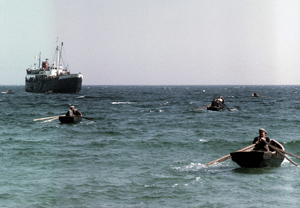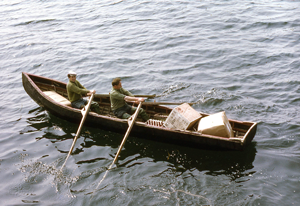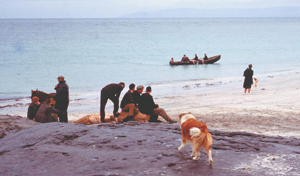‘SOMEWHERE ENTIRELY DIFFERENT’— INISHEER IN THE 1960s
Published in Features, Issue 3 (May/June 2023), Volume 31By Dennis Kennedy
A photo recently in the Irish Times of the MV Naomh Eanna languishing on her side in Dublin’s Grand Canal Basin evoked memories of my first visit to Inisheer in 1965. Then the boat was most people’s only means of getting to and from the island, as it was for all goods and livestock. The voyage from Galway to the island took three or four hours, or more in stormy Atlantic weather.
We—my girlfriend and wife-to-be—had met recently, both working in the Belfast Telegraph. I had shown her something of the North and she, a Dubliner, declared that she would show me somewhere entirely different—so we ended up on Inisheer for the Easter weekend. And different it was.
Nowadays much faster boats and aircraft from Galway, or from Doolin in County Clare, can cut the journey to half an hour or less, but I do not envy today’s travellers their comfort, speed and convenience—for they miss a unique journey into a magical world, which compensated for the smelly boat and very possibly a bout of seasickness.
LIKE CANALETTO’S PORTRAYAL OF THE GRAND CANAL
In those days the island’s small jetty could not accommodate the Naomh Eanna, which had to drop anchor half a mile out to sea off Inisheer’s silvery beach. The travellers then had a panorama before them that was in a way as exciting as Canaletto’s portrayals of the Grand Canal. The sea was suddenly populated not with gondolas but with currachs. Some were pulling out from the strand, others heading back from the boat, loaded with goods and people. I remember counting twenty currachs at a time.
That day the sea was not really stormy, but a heavy swell was giving disembarking passengers something to think about, for their only way to dry land was to be handed down via a door in the ship’s hull near the waterline by members of the crew into the welcoming arms of a boatman standing in the currach, as it lurched and pitched on the swell. Getting from the currach onto the strand meant more manhandling and probably wet feet.
The strand was crowded when we reached it, for the arrival of the Naomh Eanna meant a busy day for everyone. On that day it was servicing Inishmore and had to go on to Kilronan, and on its way back to Galway it was calling again at Inisheer to take on passengers and goods.
CATTLE TRANSFERS
When we had sorted out where we were staying, we returned to the strand for a second view of the Naomh Eanna and of the riveting procedure of getting a number of cattle transferred from the strand to the ship, half a mile out to sea. They were herded down to the strand, fitted with a halter round their necks and a sort of big nappy fixed to their back and around their belly, with a hook on top which would enable the ship’s crane to lift them out of the sea and swing them up on to the deck, one by one. This was no easy task, involving men, dogs and a great deal of shouting and barking. Each cow was encouraged into the sea by the dogs and directed to the back of a currach, where it was tethered and obliged to swim until it reached the ship. The hawser from the ship’s crane was swung out over the currach and each cow was lifted bodily out of the water, swung up and over the boat, and then gently lowered onto the deck. The cows expressed their displeasure at the whole exercise by incessant bellowing.
As the Naomh Eanna headed off for Galway, the bustling strand was quiet and calm—some islanders were lingering for an evening stroll to see off the ship or to enjoy an evening pipe. After that first day of excitement, we awoke to a different island. A dense mist enshrouded everything, and the few people about were ghostly shadows. I had the feeling that we were on a ship, and that the Naomh Eanna was the land we had left behind.
For the next two days we met with nothing but kindness. People told us that we were the only visitors on the island. It was Irish-speaking, but many were able to converse in English. Some elderly men that we met apologised for having very little English.
The one topic of conversation in any language was the sceim or ‘schame’ in Ulster English. The ‘schame’ was a government scheme to save Inisheer from devastation by sand. Fine grains blown in from the strands by strong Atlantic winds were burying whatever fertile ground the island had and threatening to engulf cottages close to the sea. Already the remains of old St Caomhan’s church were half-buried by intruding sand. The islanders regarded the sceim/schame with the robust scepticism afforded most government schemes. Photographs from that year show that the special grasses selected to grow in and hold back the invading dunes were having a hard task of it. Land exposed to the Atlantic winds had all the appearance of desert.
KODACHROME SLIDES
That visit in 1965 was only for four days. A keen amateur photographer, I had my new 35mm camera loaded with a Kodachrome film. This film had recently brought colour photography within reach of an amateur. It had to be posted back to Kodak for processing and a box of transparencies would be returned. These had to be viewed either through a hand-held viewer or via a projector and screen. Each transparency was unique in the sense that it was not possible to make a print of it, or a duplicate slide.
I soon had my slides from Kodak. They looked very good. My first thought was to write an article and have it printed along with the best of the slides. No newspapers, nor even magazines, printed colour pictures in those days. I wrote my article and selected about six of my best slides and sent them off to an agent who claimed that he could place material with American publications printing in colour.
I had other things to occupy my thoughts in the summer of 1965: my girlfriend became my wife in September, and I was offered a job in Ethiopia. Nothing had come from the agent. Eventually he told me that he had sent my article to a publisher who now said that he had never received them. In a few weeks he informed me that my article and the slides had been lost. I accepted that the slides were gone and that I could do nothing about it. At least I still had a dozen or so interesting pictures of Inisheer.
FIVE YEARS LATER, 50 YEARS LATER
Five years later, in June 1970, I was back on the MV Naomh Eanna heading for Inisheer, this time with my wife and two young children. As we left Galway the weather was bright and calm, and the Atlantic was on its best behaviour. All went well and the sun shone for the whole two weeks we were there. I had plenty of opportunity to take as many photos as I wished. My only regret was that two of the lost slides could not be replaced—there were no cattle being shipped out on the Naomh Eanna, and I had no second chance to photograph the great traffic jam of donkey carts outside the chapel on Easter Sunday morning.
For the next half-century, the Inisheer slides sat in a variety of boxes among growing shelves of slides. Then a sudden urge six years ago led to a clearing-out of the archives. I found that I still had 50 slides of Inisheer, most of them in good condition. I laid out a photo-book and had it professionally printed in A4 format, costing more than £40 per copy. I guessed that many of the people portrayed in the book were relatives of today’s islanders, particularly today’s schoolchildren, and so I sent a copy of the book to the island’s primary school. Soon I was asked for copies of the book by islanders. Such was the demand that I compiled a paperback version in a smaller format, published by myself and selling at a much lower price.
After seeing this year’s photo of the near-submerged Naomh Eanna I searched my Inisheer pictures and counted five of the ship—showing passengers being transferred to currachs, cattle being herded into the water and the ship at sea.
There is irony in seeing the ship on its side, possibly abandoned, for one of the sights of Inisheer is a wrecked ship, the MV Plassy, which hit rocks in 1960 and was blown ashore. All its crew were rescued. Today it is a crumbling ruin but has now achieved cult status as the wreck seen on the foreshore of ‘Craggy Island’ in the TV comedy Father Ted.
The Naomh Eanna must be known to generations of Irish schoolchildren who travelled in it to Inisheer for Irish-language courses. Few school outings could have been so exciting. It would be a pity if the ship is left to fall apart or sent to the breaker’s yard. Apart from its connection with the Aran Islands, it has some interest as one of the few remaining vessels built in part at least in the Liffey Dockyards.
In no way can it be returned to the Aran Islands, but restoration and a permanent berth in the Canal Basin would seem a good idea. The Liffey, once the major port for Ireland, has become a shipless river, a bridge-locked pond. In many people’s memory the stretch of the Liffey down from the Custom House was rarely without several berthed ships—a Guinness boat or two, the Trinity House vessel, often a Naval Service patrol ship, and on occasion a visitor from another country’s navy, and for a long period the venerable Kilkenny lingered on the north side under various disguises. Whatever happened to it?
Dennis Kennedy is a former Deputy Editor of the Irish Times.




















